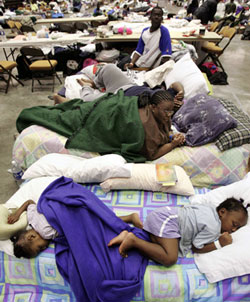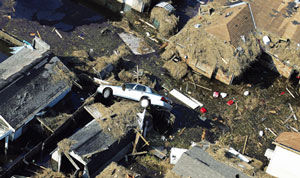The tragedy of Hurricane Katrina: Two years later
By Jesse MuhammadStaff Writer | Last updated: Aug 27, 2007 - 10:32:00 PM
What's your opinion on this article?
- Susan L. Taylor Calls for a ‘Day of Presence’ in New Orleans (FCN, 08-24-2007)
- Post-Katrina survival: The struggle continues (FCN, 08-04-2006)
- The hidden story in New Orleans (FCN, 01-25-2006)

The wake of Hurricane Katrina�s devastation is still lingering with thousands of displaced children and relatives, and graphic economic loss.
|
NEW ORLEANS (FinalCall.com) - Two years ago, 85 percent of the city of New Orleans was underwater and the Gulf Coast quickly became the center of world attention due to the surge of Hurricane Katrina. Although the water has subsided, city officials and hurricane survivors are still up to their necks in problems stemming from a string of broken promises by the U.S. government. In the midst of this, the African American Leadership Project (AALP) and others are hosting an array of events for the 2nd Katrina Anniversary Observance and Commemoration.
In August 2005, Hurricane Katrina laid to waste nearly 90,000 square miles of land, which is equivalent to the size of the United Kingdom, according to the U.S. Senate. The mayhem was aired by all media outlets of destroyed homes, people left stranded on rooftops, no food in sight, floating dead bodies washing ashore, no water accessible, Superdome trauma, some cities wiped off of the map and people crying out on national television for help. Who responded? President Bush? FEMA? Red Cross? “Their own government does not care for them,” said one news reporter. “The same idiots who can’t get a bottle of water into New Orleans in three days, are the same idiots trying to prosecute a war in Iraq.”
Young men banded together to take charge of their neighborhoods and care for the elderly. Their efforts to survive was portrayed as looting and the terms “refugees,” “evacuees,” and “animals” began to vibrate through the airwaves to describe those who were the victims of government neglect. The water was not their only enemy, but police officers and helicopters began shooting at flood victims. The scene in New Orleans became chaotic as thousands of people waited for buses to spirit them away from the destruction of Katrina’s touch. Many flocked to the Louisiana Superdome for safety and comfort until relief came. Over 20,000 un-bathed, exhausted and hungry persons crammed into every nook and cranny of the facility, seeking sanctuary, but quickly found more stress and despair. With insufficient staff, lack of supplies and inoperable air conditioning, the domed stadium became a horror. Toilets overflowed with feces, showers were broken, and evacuees inhaled the stench of rotten garbage. Unable to cope, many began to die in their sleep, and angry citizens became impatient with the slow response by the government. Those who were unable to make the journey to the dome, slept on bridges, made “help” signs on rooftops, only to have their cries unheard.
Families were separated and thrown on buses heading to Texas, Little Rock, and other states. People were given one-way tickets to states with no idea of how they would survive, while others commuted in vehicles. According to various news reports, the Bush Administration was made aware of the potential threat of Katrina well in advance, but ignored the memos. It took the harsh words of Mayor Ray Nagin to get minimal assistance from the government and a visit by the President, who was only seen on television visiting the undamaged areas.

A car sits on the rooftop of a home surrounded by floodwaters from Hurricane Katrina Sept. 4, 2005 in New Orleans, La. It was estimated that 80 percent of the city was under floodwaters after levees broke and began to leak around Lake Ponchartrain.
|
On September 11, 2005, the Honorable Minister Louis Farrakhan led a Millions More Movement delegation on a whirlwind tour of the wasted cities in the Gulf Coast to hear from the hurricane survivors in town hall meetings. Minister Farrakhan began boldly posing the question of what happened to the levees and from there news reports began circulating that someone may have exploded the levees, reminiscent of what took place in the early 1920s.
Months later in 2006, members of the Senate Homeland Security and Governmental Affairs Committee released a report titled “Hurricane Katrina: A Nation Still Unprepared,” that called for the dismantlement and rebuilding of FEMA in the wake of its flawed response to Hurricane Katrina. Hurricane Katrina has been recorded as the greatest disaster to hit the shores of America and has left over 250,000 people displaced throughout the country in over 44 states. Those who are displaced are still in dire need of assistance economically and psychologically. Billions of dollars in property damage assessed and torn areas such as the Lower Ninth Ward have been left untouched. Tourism has increased in New Orleans for sporting events and parties, but 70 schools in the Orleans Parish remain closed. No mental health services available nor hospitals to serve the uninsured poor. An accurate number of lost lives have yet to be recorded as bodies were being found a year later in molded homes.
Hurricane survivors have expressed their frustration with the bureaucracy of FEMA, Red Cross and the Louisiana Road Home program. “We have filled out so much paperwork. I am tired of filling out papers and seeing case managers. Just give us the money!” stated Cynthia Slaughter, who is displaced in California. “We are so tired and sometimes you just want to kill yourself.” They have faced ever-changing deadlines and the stress of having their vouchers cut short. Many survivors have pointed the finger at these agencies, Governor Blanco and Mayor Ray Nagin. Mayor Nagin has challenged that he has done the best he can with the little assistance he has been given by the state and federal government.
The welcoming mat for survivors became worn out in cities across America who blamed problems on the influx of New Orleans residents into their neighborhoods. “We want them to go home!,” yelled one White man at a Houston town hall meeting held in 2006 in a high-profile suburb. “We have done all that we can for these people.”
What happened to the Katrina Aid?
According to news reports, allies offered $854 million in cash, and in oil that was to be sold for cash, but only $40 million has been used. Most of the aid went uncollected, including $400 million worth of oil. Some offers were withdrawn or redirected to private groups, such as the Red Cross, which has been under fire post-Katrina for its apathy towards helping the hurricane survivors. U.S. taxpayers have carried the weight of the government’s poor recovery efforts to the tune of $125 billion in taxes post-Katrina. Since 2005, news reports have circulated that the government had rejected aid from several foreign nations. During his talk in New Orleans at the 2007 Essence Music Festival, Presidential Candidate Barack Obama pointed out that $165 million a day is being spent on the war in Iraq. “For less than the amount spent in one month in Iraq, all of New Orleans could have been completely rebuilt,” he said.
Commemoration events planned
Commemoration organizers see the need to take a serious examination of what can be done to change the present deplorable condition. The AALP will close out the week-long events with an impacting “Hands Around the Dome Ceremony” on Sept. 1 at the Louisiana Superdome.
“We try to overcome the pain and suffering that occurred in this building [Superdome], which along with the Convention Center has become symbolic of the general pain and suffering caused by human error and neglect during Katrina,” stated Mtangulizi Sanyika, AALP Project Manager.
The AALP events will begin on Aug. 30, with its 2nd Katrina lecture series at Dillard University-Cook Theatre to raise questions that situates Katrina in the broader context of the historic struggle for Black liberation and human justice.
On Aug. 31, a two-part “Local and National Dialogue” will take place at the McDonough 35 High School Auditorium. The Local Dialogue will examine the “State of theRecovery and Flood Protection,” and the National Dialogue on the issue of “Getting Ready for Hurricanes and Rebuilding Cities as New Emerging National Priorities.”
(For more information, contact the AALP Chair, Gail Glapion, or the Project Manager, Mtangulizi Sanyika at (713) 376-3364, e-mail: [email protected].)
INSIDE STORIES AND REVIEWS
-
-
About Harriett ... and the Negro Hollywood Road Show
By Rabiah Muhammad, Guest Columnist » Full Story -
Skepticism greets Jay-Z, NFL talk of inspiring change
By Bryan 18X Crawford and Richard B. Muhammad The Final Call Newspaper @TheFinalCall » Full Story -
The painful problem of Black girls and suicide
By Charlene Muhammad -National Correspondent- » Full Story -
Exploitation of Innocence - Report: Perceptions, policies hurting Black girls
By Charlene Muhammad -National Correspondent- » Full Story -
Big Ballin: Big ideas fuel a father’s Big Baller Brand and brash business sense
By Bryan Crawford -Contributing Writer- » Full Story






 Click Here Stay Connected!
Click Here Stay Connected!








